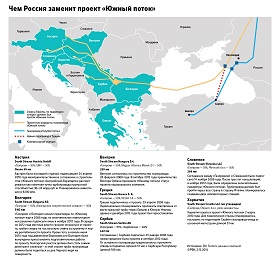Over the last few months since the decision not to build the South Stream pipeline experts around the world have been trying to guess the Russian authorities’ next step: will Moscow admit the project is non-viable, will it try to reach agreement with European officials, or will it come up with something quite different?
The western media have often failed to pay enough attention to the events that are really shaping the future of Central and South-East Europe in the area of energy. While all the European media, both big and small, were preoccupied with the details of Alexis Tsipras’ visit to Moscow, a remarkable meeting took place on 7 April 2015 in Budapest. Following an initiative by the Hungarian Foreign Minister Peter Szijjarto, a meeting was organised between the foreign ministers of Hungary, Serbia, Macedonia, Greece and Turkey (Ankara being represented by Volkan Bozkir, Minister for EU Affairs). The composition of this group certainly recalls the proposed route of the Turkish Stream pipeline, a project which was Russia’s reaction to the plan to halt development of the South Stream. Moreover, by all indications the group will be institutionalised and meetings of the member countries will be regular. It is notable that Bulgaria, Romania and Croatia were not invited to these talks, although they are also part of the Balkan Peninsula.
In the joint declaration on strengthening cooperation in the energy sphere which was signed at the end of the meeting, the parties “expressed their support for the idea of creating commercially viable routes and sources by supplying natural gas from Turkey to countries in Central and South-Eastern Europe via the territory of the member countries”. The fact that supplies of natural gas play a special role for the countries involved in the meeting was officially confirmed. Apart from the necessary references to the development of the Southern Gas Corridor, it is also noteworthy that these countries want to build a common gas infrastructure, using among other things the financial resources of the European Union.
Overall, the behaviour of Hungary after Vladimir Putin’s visit in February 2015, which was seized upon with some agitation by the western media, merits a separate analysis. Even before the actual, visit, Hungary’s foreign minister Peter Szijjarto had a discussion with Jyrki Katainen, the European Commission’s Vice-President for Jobs, Growth, Investment and Competitiveness, about the possibility of building the Hungarian section of the gas pipeline using EU financial resources under the Juncker Plan. The former prime minister of Finland assured the diplomat that to complete national projects in full it was only necessary to involve the private sector and to “fit in with” the investment plan. If it fulfilled these conditions, Hungary could be allocated part of the overall package of 300 billion euros to cover the 1.5 to 1.7 billion euros needed to build the 740-km section of the pipeline on Hungarian territory.
Hungary’s president Janos Ader stated during his visit to Turkey in March 2015 that Turkey needed to “get a move on” with preparing its plan for financing the Turkish Stream, since “there are also alternative proposals on the European Union’s table”. In view of the fact that Gazprom intends to cease supplying gas via Ukraine in 2019, when its contract with Naftogaz of Ukraine expires, the energy future of the Balkan peninsular countries and South-East Europe is up in the air. The seriousness of Gazprom’s intention to avoid Ukraine in every possible way is also demonstrated by the fact that since 2014 more gas has been supplied to Europe via the Nord Stream pipeline than via the Slovak-Ukrainian border.
Gazprom is also trying to speed up the progress of agreement and construction, since in order to supply gas to Europe by 2018-2019 construction should be starting now. The Russian giant’s leadership set the objective of concluding an intergovernmental agreement with Turkey in the second quarter of this year in order to deliver the first gas via the new pipeline by December 2016. Gazprom has made substantial concessions to the Turkish side, agreeing to a discount of 10.25% instead of the originally proposed 6%.
The hurry is also driven by the way the situation around Iran is developing. The news that the deal had been reached was followed immediately by a visit to Iran by the president of Turkey to discuss opportunities for developing economic cooperation. President Erdogan even promised to buy more gas from Iran if Tehran reduced the price. Turkey stands to benefit from virtually whichever way the situation develops: it will become one of the biggest transit states, and moreover it is very likely than a number of distribution hubs will be built on its territory. Ankara is not going to obstruct either the Turkish Stream or other projects.
The possibility of Iran being included in the Southern Gas Corridor, or the question of building an alternative route in order to diversify gas supplies to Europe, has become pressing in recent days.
The Nabucco project, which had existed as an alternative concept for more than ten years, was finally rejected in 2013. It has been assumed that gas from Azerbaijan and Turkmenistan would be delivered to Europe, but for Turkmen gas to be exported without passing through Russia it would have been necessary to build a trans-Caspian gas pipeline on the bed of the Caspian Sea, which was bound to meet with protests by Russia and Iran. While the status of the Caspian Sea’s waters remains unresolved, Turkmenistan will not be able deliver supplies of gas to Europe bypassing Russia and Iran.
The TANAP project, which logically emerged after the collapse of Nabucco, can so far count only on gas from Azerbaijan (the Shah Deniz gas field). The successful implementation of TANAP depends to a substantial degree on the desire of Iran to supply gas to Europe, since the Shah Deniz field will produce about 16 billion cu m per year. It is assumed that 6 billion cu m of this will be delivered to western regions of Turkey, and 10 billion cu m to Europe. In addition, the forecast output of 16 billion cu m was announced by BP, one of SOCAR’s leading partners in the project. Iran’s deputy oil minister Ali Majedi has said that Azerbaijan will be able to produce only half of this figure per year (8 billion cu m).
Thus Iran has proved to be the only state capable of supplying Europe with the amount of gas required. Iran, which has the biggest gas deposits in the world, can, if it so wishes, send Europe the 16 billion cu of per year that it needs to reach full capacity (32 billion cu m per year).
Nevertheless, in the short and medium term it is very unlikely that Iran will try to squeeze Russia out of the European gas market. First, Iran’s president Hassan Rouhani has stated that the priority is to provide the population of Iran with gas. Secondly, at this stage Iran does not have the appropriate infrastructure for large-scale exports of gas to Europe. Thirdly, most of Iran’s gas exports are controlled by the Revolutionary Guards, an organisation which on the one hand does not meet the European Union’s transparency requirements and on the other always tries to retain complete control over projects in which it is involved. Fourthly, following the lifting of sanctions Iran will be in a position to start building a long-planned gas pipeline to Pakistan and to deepen its cooperation with China.
So if there are no competitors of equal strength, what is preventing Gazprom from implementing the project? It turns out that there is a range of factors obstructing construction of the Turkish Stream. This is primarily to do with the stance of the European Commission, which despite become more nuanced since Jean-Claude Juncker came into office still takes a sceptical view of any attempts by Russia to strengthen its position in Central and South-Eastern Europe. There is also a number of countries which are not involved in the project and which currently receive gas via Ukraine (the Czech Republic, Slovakia etc), which are trying to obstruct the Turkish Stream project. It is noteworthy that the EU’s current Energy Commissioner Maros Sefcovic is a Slovak. The Slovak company Eustream has proposed its own project called Eastring, instead of the Turkish Stream, which theoretically would run through Slovakia, Hungary, Romania and Bulgaria. It remains only to explain who would pay for this pipeline.
The main obstacle to rapid construction of the Turkish Stream, however, is the expense of the project, especially given the difficult market conditions in Russia. The cost of the total complex of works to construct South Stream has been approaching 40 billion dollars.
Gazprom has decided to hand over most of the construction of the gas transport system in Europe to national governments in order to comply with the EU’s Third Energy Package, and to reduce its own expenditure on the project to a defined limit. A number of states, however, were offered extremely favourable state credits to build their sections, which minimises the Kremlin’s opportunities to reduce its costs. Gazprom spokespersons maintain that modernising Ukraine’s gas transport system would cost 19.5 billion dollars, and if this claim is really true it would be a strong argument in favour of the Turkish Stream. In any case, the decisions taken to date indicate that the high cost of the project for Gazprom is not an insuperable obstacle.
There are often claims that there is a glut in the European natural gas market and that it makes no sense for Russia to build new gas pipelines, since the European demand is already covered. It is noteworthy that the slump in gas consumption in Europe began in the crisis year of 2009, and before that no negative trends were observed. When they ran into the unavoidable need to cut costs, many countries (with Germany, Britain and Poland in the lead) started using cheaper coal instead of other substantially cleaner energy sources, despite their obligation to reduce greenhouse gases by 40% by 2030. According to the IEA, gas consumption in Europe will not grow right up to 2030, when it will be necessary to compensate for the nuclear power stations which will have gone out of service by then.
Balkan countries such as Serbia and Macedonia, while not being members of the EU, can benefit in another way from the Turkish Stream, since coal accounts for 75.7% and 76.9% respectively of these countries’ national consumption. Skopje and Belgrade are not part of the European gas system, but they need an alternative supply route, since Russian gas still comes to them via Ukraine.
Overall, given the changes of recent days and months, implementing the Turkish Stream no longer seems to be simply a Gazprom fantasy. With gas pipeline construction on the territory of Hungary, Serbia, Macedonia and Greece having been delegated to national governments, two pipelines are officially being created – the Turkish Stream, to the Turkish-Greek border, and the Tesla, from Greece to Hungary. The latter two countries are resisting pressure from Brussels, since they are governed by populist parties which are positioning themselves as the sole defenders of the national interest. In this situation, Gazprom is not breaking the rules of the Third Energy Package, while at the same time securing most of South-East Europe.
Another circumstance favouring Gazprom is the fact that in the case of the Turkish Stream all the commercial risks are being taken by one company, and moreover one with state involvement. The second advantage of the gas giant is its size.
In giving Turkey and Greece (not to mention other participants in the project) a 10% discount, Gazprom is offering an extremely attractive price. If in 2015 the company can sign an intergovernmental agreement with the Turkish side, decide the location of the distribution hub and start actual construction, the Turkish Stream project has every chance of becoming a new milestone in the history of Central and South-Eastern Europe.






